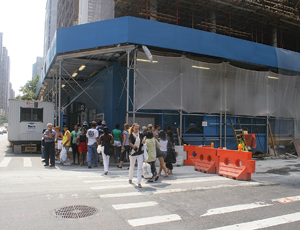Call it a sidewalk shed or bridge: pedestrian protection by any name is viewed as a Big Apple eyesore to many, including local building officials and the New York City chapter of the American Institute of Architects. Through a design competition, they are trying to improve the covers, which they say number 6,000 and add up to more than 1 million linear feet of unsightliness.

In August, the New York City Department of Buildings and AIA NY launched an international design competition called urbanSHED to create a designer shed that improves the pedestrian experience while maintaining or exceeding safety requirements. The goal is to “change the landscape,” said DOB Commissioner Robert LiMandri at the competition’s August 19 launch. LiMandri is spearheading the undertaking with support from other city departments and interested groups. “This can have an impact citywide, and what happens here can be picked up elsewhere,” says Rick Bell, AIA NY’s executive director.
The competition brief, produced by AIA NY, says the winner will meet or exceed such criteria as safety, sustainability, and economy and will comply with all applicable laws. A nine-member jury will seek a design that increases light and air to the sidewalk; complements various streetscapes, including residential, retail, industrial and commercial; controls foot traffic; offers easy access to building entrances, improves structural connections and fastening details; and provides energy-efficient lighting. Details are available at www.urbanSHED.org.
Registration for the competition ends on September 18, and all entries are due on October 2. Three finalists will be announced during the week of October 7, and each will receive a $5,000 stipend to refine their entries. The winner, which can be an individual, group or firm, will be announced on December 17. The winner will receive a $10,000 prize, and the design will be built as part of the Alliance for Downtown New York’s Re-Construction Art Program.
DOB plans to issue an official bulletin establishing the winning design as an approved standard for use. As LiMandri explains: “No one will have to wait on line to get a permit to use it.”

Post a comment to this article
Report Abusive Comment